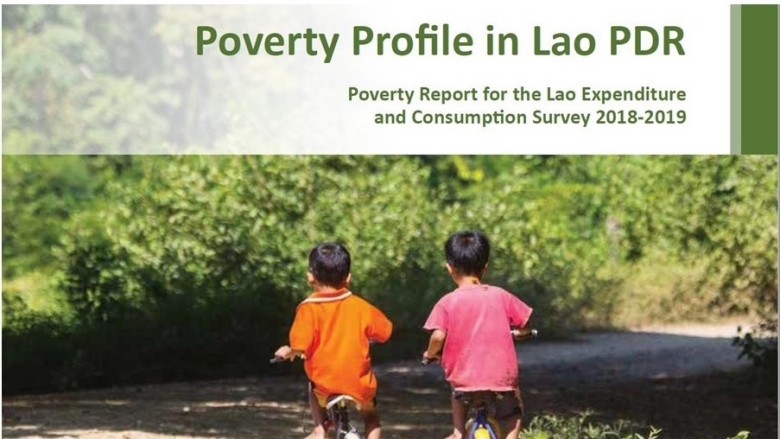The Poverty Profile in Lao PDR and Poverty Assessment 2020: Catching Up and Falling Behind show that Lao PDR has made remarkable progress in reducing poverty over the past 25 years, but also that many recent gains made against poverty are threatened by the impact of the COVID-19 pandemic on the Lao economy.
Published by the Lao Statistics Bureau and the World Bank in both Lao and English, the Poverty Profile outlines the results of the latest Lao Expenditure and Consumption Survey (LECS), carried out nationwide in 2018-19.
The Poverty Assessment 2020: Catching Up and Falling Behind, published in English, analyses the LECS data in more depth and explores the factors behind emerging trends. An Overview of the assessment is also available.
KEY FINDINGS
Poverty in Lao PDR has continued to fall. The poverty rate more than halved between 1993 and 2019, falling from 46 percent to 18 percent – mirroring rapid Gross Domestic Product (GDP) growth of an annual average rate of 7.3 percent during the same period.
Rising farm incomes have driven poverty reduction. Since 2013, agricultural households have moved from subsistence rice cultivation toward the commercial production of cash crops.
The disappearance of off-farm jobs has slowed poverty reduction. Since 2013, the industry sector has created few jobs, while the service sector has grown slowly.
Remittances helped make up for lost non-farm income. Between 2013 and 2019, remittances from migrants became a source of income for nearly 15 percent of households, accounting for 3.7 percentage points in poverty reduction.
In the absence of new jobs, rapid economic growth did not bring an equally high rate of poverty reduction. From 2013 to 2019, a 1 percent increase in GDP per capita generated a decline in the poverty rate of only 0.67 percent.
Inequality has risen, driven by an increasing concentration of consumption at the top end of the distribution.
Poverty has fallen faster in rural areas than in towns, thanks to an improvement in farm incomes and remittances among rural households. The rural poverty rate dropped by 7.6 percentage points to 23.8 percent between 2013 and 2019.
Southern and northern provinces drove the impressive progress in reducing poverty. Between 2013 and 2019, poverty rates decreased in all southern provinces except in Attapeu. Overall, poverty in the south fell from 29.9 percent in 2013 to 17.7 percent in 2019, making it the least-poor region. Poverty also declined in all northern provinces except Xayaboury, with Bokeo experiencing the largest reduction in absolute terms.
Poverty levels stagnated in the central region, which went from being the richest region to the poorest. The poverty headcount rate declined only slightly from 23.5 to 21.5 percent, leaving the region—previously the wealthiest—with the highest incidence of poverty.
Poverty remains high among minority ethnic groups and fell less quickly among poorly educated households. In 2019, a poverty rate of 34.6 percent was observed among people living in households headed by someone with no formal education. This is ten times higher than among households headed by those who have completed secondary education.
The Lao labor market is characterized by agricultural workers facing seasonal fluctuations in labor demand, high informality, and a growing number of public sector jobs. In recent years, labor market conditions have not supported inclusive growth. All sectors, except the public and hospitality sectors, experienced a net decline in employment in the six years after 2013
The COVID-19 outbreak has brought an unprecedented employment shock, adding pressure to the weak job market. A sharp drop in tourism has led to job losses in retail trade, transport, and hospitality, which together account for 11 percent of total employment. The fall in travel and tourism is expected to last well into 2021, leading to income loss or even permanent job losses if the crisis is prolonged.
Remittances are likely to drop sharply due to the pandemic, creating a big challenge for those who rely on them to survive. Approximately 70 percent of remittances sent to Lao households are from abroad. But the pandemic has resulted in job losses among migrants, and many have returned home.
The COVID-19 pandemic is expected to partially reverse the poverty reduction of 2013–19. Slowdown in the non-agricultural sectors, combined with a decline in remittance flows, is expected to have a negative impact on poverty.
The poor consist of three distinct groups requiring different interventions:
- The first group (41 percent of the poor) consists of remote, low-educated, agricultural households who are predominantly ethnic minorities.
- The second (45 percent) consists of better-connected but low-educated agricultural households.
- The third group (14 percent) consists of households engaged mainly in low-productivity nonfarm activities, with education levels that are still low but higher than in the other two groups. This group is most likely to be affected by pandemic-related shocks.
Recommendations
A broad set of interventions targeting different groups of the poor is required to maintain poverty reduction momentum in Lao PDR. The combination of low education and jobless growth has limited off-farm opportunities for the poor, increasing their reliance on agriculture. Interventions to reduce poverty should focus on five areas:
- Closing the infrastructure gap and improving connectivity in remote areas where ethnic minorities are concentrated;
- Boosting agricultural productivity through promoting crop diversification and commercialization;
- Promoting low-skill job generation by easing business regulatory restrictions and introducing an employment promotion program;
- Adopting supply- and demand-side measures to promote investment in education and skills development that will improve access to opportunities for the next generation;
- Expanding safety nets to provide an income buffer for households with limited livelihood options.
